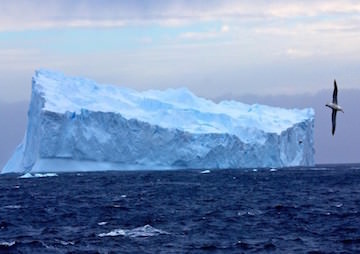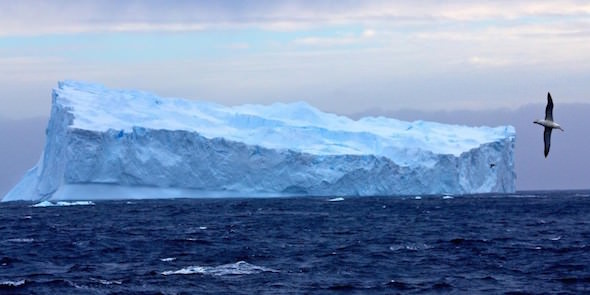Giant Calving Icebergs May Slow the Pace of Climate Change
Massive melting icebergs increase the carbon storage capacity of the Southern, or Antarctic, Ocean by releasing vital nutrients that stimulate the growth of plankton.
By Tim Radford / Climate News Network

Researchers have found that as huge icebergs melt, iron and other minerals are released into Antarctic waters. (Brent De Vries via Flickr)
This Creative Commons-licensed piece first appeared at Climate News Network.
LONDON — British scientists have identified the monsters that fertilise the Southern [or Antarctic] Ocean and help remove carbon dioxide from the atmosphere.
Giant icebergs drifting northwards could be responsible for storing up to a fifth of all the carbon that sinks into the south polar waters.
Geographers at the University of Sheffield report in Nature Geoscience journal that they analysed 175 satellite images of ocean colour — an indicator of phytoplankton activity.
They learned that each huge iceberg, as it breaks off the ice shelf and begins to float away, also begins to cascade iron and other vital mineral nutrients in its melting waters. This is enough to stimulate ferocious plankton productivity for up to a month in its wake.
The icebergs are not small — the researchers define “giant” as at least 18 kilometres in length — and nor can they be very frequent.
Area of influence
“We detected substantially enhanced chlorophyll levels, typically over a radius of at least four to 10 times the iceberg’s length,” says Grant Bigg, Professor in Earth Systems Science, who led the research.
“The evidence suggests that carbon export increases by a factor of five to 10 over the area of influence, and up to a fifth of the Southern Ocean’s downward carbon flux originates with giant iceberg fertilisation.
“If giant iceberg calving increases this century, as expected, this negative feedback on the carbon cycle may become more important than we previously thought.”
The guess is that the Southern Ocean accounts for perhaps 10% of the ocean’s absorption of carbon dioxide from the atmosphere.
Research such as this is part of the global process of understanding all the intricacies of the carbon cycle — in turn, an important part of modelling future climate change as a consequence of rising levels of greenhouse gas in the atmosphere, driven by human combustion of fossil fuels.
“Picking out some trends from
natural variability is like listening
for a soft sound in a noisy room.”
But, in another sense, the discovery is a reminder of how little humans know about the oceans that cover 70% of the globe.
To reinforce this reminder, researchers from the UK’s National Oceanography Centre (NOC) at the University of Southampton report in Global Change Biology that most of the data so far collected covers timespans too short to be of value in detecting climate change.
They argue that it would take at least 15 years, and perhaps more than 30 years, of continuous observation to detect changes in ocean biology as a consequence of increases in atmospheric carbon dioxide levels.
Marine life
It’s the old scientific problem of detecting the “signal” amid the noise of data. Phytoplankton are the ocean’s green things: they nourish all other marine life, directly or indirectly, and some of the atmospheric carbon absorbed by these photosynthetic microbes eventually ends up as bone and shell on the ocean bottom.
But to establish that more carbon dioxide in the atmosphere will necessarily mean more carbon sequestered in the ocean’s abyssal plains, or that increasingly acidic oceans will limit the process, is not so easy.
“Picking out some trends from natural variability is like listening for a soft sound in a noisy room,” says Stephanie Henson, NOC senior research fellow and lead author of the study.
“This research really highlights the importance of continuing long-term observations at a range of sites across the ocean, so we can better detect the way it is changing.
“Without long-term data sets, it is difficult to understand how ocean biology may respond to climate change.”
Tim Radford, a founding editor of Climate News Network, worked for The Guardian for 32 years, for most of that time as science editor. He has been covering climate change since 1988.
Your support matters…Independent journalism is under threat and overshadowed by heavily funded mainstream media.
You can help level the playing field. Become a member.
Your tax-deductible contribution keeps us digging beneath the headlines to give you thought-provoking, investigative reporting and analysis that unearths what's really happening- without compromise.
Give today to support our courageous, independent journalists.






You need to be a supporter to comment.
There are currently no responses to this article.
Be the first to respond.